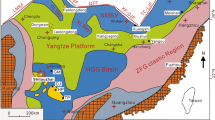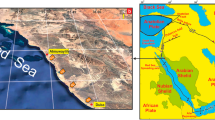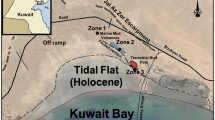Abstract
Selective dolomitization, where certain carbonate components are preferentially dolomitized over others, can be significant in the overall dynamic context of the global magnesium cycle. Thus, the abundance of these components can modify the Mg balance between the ocean and sediments, thereby disrupting the Mg cycle in certain geological times. Selective dolomitization may be connected to the apparent correlation between global dolomitization events in the Neogene and the synchronous rise in species abundance of coralline red algae (CRA), but the underlying issue remains unclear. In the Caribbean islands, excellent examples of Neogene partially dolomitized carbonates containing coralline red algal facies are described to understand selective dolomitization of different components (grains and matrix) by examining the well-preserved outcrop of partially dolomitized Mio–Pliocene carbonates at the Seru Grandi locality on Bonaire Island, in the Caribbean. The degree and timing of selective dolomitization of various carbonate components are assessed using petrographical and geochemical methods. The micrite matrix is dolomitized first, followed by coralline red algal bioclasts, and subsequently all other grains. Dolomite crystals appear to originate from within and immediately around coralline algal fragments, suggesting that dolomite could have initiated from internally sourced Mg of the CRA’s high-magnesium calcite skeleton. Collectively, these observations suggest that selective dolomitization is controlled primarily by reactive surface area of the carbonate components, but it is less clear as to whether there is a dependency on original mineralogy.














Similar content being viewed by others
Availability of data and material
Data and material are available upon request.
Code availability
Not applicable.
References
Adams JE, Rhodes ML (1960) Dolomitization by seepage refluxion1. AAPG Bull 44(12):1912–1920
Aguirre J, Riding R, Braga JC (2000) Diversity of coralline red algae: origination and extinction patterns from the Early Cretaceous to the Pleistocene. Paleobiology 26(4):651–667
Alexander CS (1961) The marine terraces of Aruba, Bonaire, and Curaçao, Netherlands Antilles. Ann Assoc Am Geogr 51(1):102–123
Al-Helal AB, Whitaker FF, Xiao Y (2012) Reactive transport modeling of brine reflux: dolomitization, anhydrite precipitation, and porosity evolution. J Sediment Res 82(3):196–215
Arvidson RS, Mackenzie FT (1999) The dolomite problem; control of precipitation kinetics by temperature and saturation state. Am J Sci 299(4):257–288
Auer G, Piller WE (2020) Nanocrystals as phenotypic expression of genotypes—an example in coralline red algae. Sci Adv 6(7):eaay2126
Baker P (1986) Pore-water chemistry of carbonate-rich sediments, Lord Howe Rise, Southwest Pacific-Ocean. Initial Rep Deep Sea Drill Project 90:1249–1256
Baker PA, Bloomer SH (1988) The origin of celestite in deep-sea carbonate sediments. Geochim Cosmochim Acta 52(2):335–339
Bandoian CA, Murray RC (1974) Pliocene-pleistocene carbonate rocks of Bonaire, Netherlands Antilles. Geol Soc Am Bull 85(8):1243–1252
Banner JL (1995) Application of the trace element and isotope geochemistry of strontium to studies of carbonate diagenesis. Sedimentology 42(5):805–824
Buchbinder B, Friedman GM (1970) Selective dolomitization of micritic envelopes; a possible clue to original mineralogy. J Sediment Res 40(1):514–517
Buchbinder LG (1979) Facies, Environment of Deposition and Correlation of the Zohar (Brur Calcarenite) Karmon, and Shderot Formations in the Ashdod Area, Geological Survey of Israel
Budd DA (1997) Cenozoic dolomites of carbonate islands: their attributes and origin. Earth Sci Rev 42(1–2):1–47
Budd DA (2019) Bed-scale spatial patterns in dolomite abundance: part II. Effect of varied fluid chemistry, flow rate, precursor mineralogy, temperature, textural heterogeneity, nucleation density and bed geometry. Sedimentology 66(7):2721–2748
Budd DA, Mathias WD (2015) Formation of lateral patterns in rock properties by dolomitization: evidence from a miocene reaction front (Bonaire, Netherlands Antilles). J Sediment Res 85(9):1082–1101
Budd DA, Park AJ (2018) Formation of bed-scale spatial patterns in dolomite abundance during early dolomitization: part I. Mechanisms and feedbacks revealed by reaction–transport modelling. Sedimentology 65(1):209–234
Bullen SB, Sibley DF (1984) Dolomite selectivity and mimic replacement. Geology 12(11):655–658
Chave KE (1952) A solid solution between calcite and dolomite. J Geol 60(2):190–192
Chave KE (1954) Aspects of the biogeochemistry of magnesium 1. Calcareous Marine Organisms. J Geol 62(3):266–283
Chave KE, Schmalz RF (1966) Carbonate–seawater interactions. Geochim Cosmochim Acta 30(10):1037–1048
Constantz BR (1986) The primary surface area of corals and variations in their susceptibility to diagenesis, Reef diagenesis. Springer, Berlin, pp 53–76
Deffeyes K, Lucia FJ, Weyl P (1965) Dolomitization of recent and plio-pleistocene sediments by marine evaporite waters on Bonaire Netherlands Antilles. SEPM Spec Publ 13:71–88
Dickson JAD (1965) A modified staining technique for carbonates in thin section. Nature 205(4971):587–587
Dix GR (1997) Stratigraphic patterns of deep-water dolomite, Northeast Australia. J Sediment Res 67(6):1083–1096
Dunham RJ (1962) Classification of carbonate rocks according to depositional textures
Embry AF, Klovan JE (1971) A late Devonian reef tract on Northeastern Banks Island, NWT. Bull Can Pet Geol 19(4):730–781. https://doi.org/10.35767/gscpgbull.19.4.730
Engel M, Brückner H, Fürstenberg S, Frenzel P, Konopczak AM, Scheffers A, Kelletat D, May SM, Schäbitz F, Daut G (2013) A prehistoric tsunami induced long-lasting ecosystem changes on a semi-arid tropical island—the case of Boka Bartol (Bonaire, Leeward Antilles). Naturwissenschaften 100(1):51–67
Felis T, Giry C, Scholz D, Lohmann G, Pfeiffer M, Pätzold J, Kölling M, Scheffers SR (2015) Tropical Atlantic temperature seasonality at the end of the last interglacial. Nat Commun 6:6159
Flügel E (2004) Microfacies of carbonate rocks: analysis, interpretation and application. Springer Science & Business Media, Berlin
Goldsmith JR, Graf DL (1958) Structural and compositional variations in some natural dolomites. J Geol 66(6):678–693
Grossman E (2012) Chapter 10: oxygen isotope stratigraphy: the geologic time scale. Elsevier, Boston, pp 181–206
Halfar J, Mutti M (2005) Global dominance of coralline red-algal facies: a response to Miocene oceanographic events. Geology 33(6):481–484
Hippolyte J-C, Mann P (2011) Neogene-Quaternary tectonic evolution of the Leeward Antilles islands (Aruba, Bonaire, Curaçao) from fault kinematic analysis. Mar Pet Geol 28(1):259–277
James NP, Jones B (2015) Origin of carbonate sedimentary rocks. Wiley, New York
Jones GD, Xiao Y (2005) Dolomitization, anhydrite cementation, and porosity evolution in a reflux system: Insights from reactive transport models. AAPG Bull 89(5):577–601
Kaczmarek SE, Sibley DF (2011) On the evolution of dolomite stoichiometry and cation order during high-temperature synthesis experiments: an alternative model for the geochemical evolution of natural dolomites. Sediment Geol 240(1–2):30–40
Kaczmarek SE, Gregg JM, Bish DL, Machel HG, Fouke BW, MacNeil A, Lonnee J, Wood R (2017) Dolomite, very-high magnesium calcite, and microbes: implications for the microbial model of dolomitization. SEPM Spec Publ 109:1–14
Kocurko MJ (1979) Dolomitization by spray-zone brine seepage, San Andres, Colombia. J Sediment Res 49(1):209–213
Kramer PA, Swart PK, De Carlo EH, Schovsbo NH (2000) Overview of interstitial fluid and sediment geochemistry, sites 1003–1007 (Bahamas transect). Proc ODP Sci Results 166:179–195
Land LS (1967) Diagenesis of skeletal carbonates. J Sediment Res 37(3):914–930
Land LS (1985) The origin of massive dolomite. J Geol Educ 33(2):112–125
Land LS (1992) The dolomite problem: Stable and radiogenic isotope clues. In: Clauer N, Chaudhuri S (eds) Isotopic signatures and sedimentary records. Lecture notes in Earth sciences, vol 43. Springer, Berlin, Heidelberg. https://doi.org/10.1007/BFb0009861
Land LS, Epstein S (1970) Late pleistocene diagenesis and dolomitization, North Jamaica 1. Sedimentology 14(3–4):187–200
Laya JC, Sulaica J, Teoh CP, Whitaker F, Gabellone T, Tucker ME, Tesch P, Miller B, Prince K, Izaguirre I (2018a) Controls on Neogene carbonate facies and stratigraphic architecture of an isolated carbonate platform—the Caribbean island of Bonaire. Mar Pet Geol 94:1–18
Laya JC, Teoh CP, Prince K, Widodo R (2018b) Dolomitization of neogene carbonate platforms: controversies on synchronous events and bioclast influence. In: Proceedings international sedimentological congress, Montreal, Quebec
Laya JC, Teoh CP, Whitaker F, Manche C, Kaczmarek S, Tucker M, Gabellone T, Hasiuk F (2021) Dolomitization of a Miocene–Pliocene progradational carbonate platform by mesohaline brines: re-examination of the reflux model on Bonaire Island. Mar Pet Geol 126:104895
Lu FH, Meyers WJ (1998) Massive dolomitization of a late Miocene carbonate platform: a case of mixed evaporative brines with meteoric water, Nijar, Spain. Sedimentology 45(2):263–277
Lucia FJ, Major RP (1994) Porosity evolution through hypersaline reflux dolomitization. In Purser B, Tucker M, Zenger D (eds) Dolomites. https://doi.org/10.1002/9781444304077.ch18
Machel HG (2004) Concepts and models of dolomitization: a critical reappraisal. Geol Soc Lond Spec Publ 235(1):7–63
Machel H-G, Mountjoy EW (1986) Chemistry and environments of dolomitization—a reappraisal. Earth Sci Rev 23(3):175–222
Mansour AS, Abd-Ellatif MT (2013) Dolomitization of the Miocene carbonates in Gebel Abu Shaar El Qiblie and Salum area, Egypt: a petrographical and geochemical comparative study. Carbonates Evaporites 28(3):347–363
Melim L, Westphal H, Swart P, Eberli G, Munnecke A (2002) Questioning carbonate diagenetic paradigms: evidence from the Neogene of the Bahamas. Mar Geol 185(1–2):27–53
Morrow D (1982) Diagenesis 2. Dolomite-Part 2 Dolomitization models and ancient dolostones. Geosci Can 9(2):95–107
Morse JW, Mackenzie FT (1990) Geochemistry of sedimentary carbonates. Elsevier, New York
Murray R, Lucia F (1967) Cause and control of dolomite distribution by rock selectivity. Geol Soc Am Bull 78(1):21–36
Paton C, Hellstrom J, Paul B, Woodhead J, Hergt J (2011) Iolite: freeware for the visualisation and processing of mass spectrometric data. J Anal at Spectrom 26(12):2508–2518
Petrash DA, Bialik OM, Bontognali TR, Vasconcelos C, Roberts JA, McKenzie JA, Konhauser KO (2017) Microbially catalyzed dolomite formation: from near-surface to burial. Earth Sci Rev 171:558–582
Rixhon G, May SM, Engel M, Mechernich S, Schroeder-Ritzrau A, Frank N, Fohlmeister J, Boulvain F, Dunai T, Brückner H (2018) Multiple dating approach (14C, 230Th/U and 36Cl) of tsunami-transported reef-top boulders on Bonaire (Leeward Antilles)–Current achievements and challenges. Mar Geol 396(1):100–113
Royse C, Wadell J, Petersen L (1971) X-ray determination of calcite-dolomite; an evaluation. J Sediment Res 41(2):483–488
Saller AH (1984) Petrologic and geochemical constraints on the origin of subsurface dolomite, Enewetak Atoll: an example of Dolomitization by Normal Seawater. Geology 12(4):217–220
Saller AH (2004) Palaeozoic dolomite reservoirs in the Permian Basin, SW USA: stratigraphic distribution, porosity, permeability and production. Geol Soc Lond Spec Publ 235(1):309–323
Saller AH, Henderson N (1998) Distribution of porosity and permeability in platform dolomites: insight from the Permian of West Texas. AAPG Bull 82(8):1528–1550
Schlanger SO (1957) Dolomite growth in coralline algae. J Sediment Res 27(2):181–186
Sibley DF (1980) Climatic control of dolomitization, Seroe Domi Formation (Pliocene), Bonaire, NA. SEPM Spec Publ 28:247–258
Sibley DF (1982) The origin of common dolomite fabrics; clues from the Pliocene. J Sediment Res 52(4):1087–1110
Sibley DF, Dedoes RE, Bartlett TR (1987) Kinetics of Dolomitization. Geology 15(12):1112–1114
Sibley DF, Gregg JM, Brown RG, Laudon PR (1993) Dolomite crystal size distribution, carbonate microfabrics. Springer, Berlin, pp 195–204
Smith AB (1990) Biomineralization in echinoderms. Skelet Biominer Patterns Processes Evol Trends 1:413–442
Sulaica JL (2015) Facies distribution and paleogeographic evolution of pleistocene carbonates in Bonaire, Netherlands Antilles
Swart PK, Burns S (1990) Pore-water chemistry and carbonate diagenesis in sediments from Leg 115: Indian Ocean. In: Proceedings scientific results, ODP, Leg 115, Mascarene Plateau, ODP, Texas A&M University, College Station; UK distributors, IPOD Committee, pp 629–645
Swart PK, Guzikowski M (1988) Interstitial water chemistry and diagenesis of periplatform sediments from the Bahamas, ODP Leg 1011. In: Austin JAJ, Schlager W (eds) Proceedings of the Ocean Drilling Program, Scientific Results, volume 101, pp 363–380
Swart PK, Melim LA (2000) The origin of dolomites in tertiary sediments from the margin of Great Bahama Bank. J Sediment Res 70(3):738–748
Swart P (1993) The formation of dolomite in sediments from the continental margin of northeastern Queensland. In: McKenzie, JA, Davies PJ, Palmer-Julson AA (eds) Proceedings of the Ocean Drilling Program, Scientific Results, Leg 133. Ocean Drilling Program, College Station, p 513–523
Teoh CP, Jacquemyn C, Laya JC (2021) The effects of dolomite geobodies within carbonate clinoforms on fluid flow and connectivity: insights from an outcrop analogue on Bonaire, The Netherlands. Mar Pet Geol 134. https://doi.org/10.1016/j.marpetgeo.2021.105344
Tucker ME, Wright VP (1990) Carbonate sedimentology. Blackwell, Oxford, p 482
Vahrenkamp VC, Swart PK (1990) New distribution coefficient for the incorporation of strontium into dolomite and its implications for the formation of ancient dolomites. Geology 18(5):387–391
Walter LM (1985) Relative reactivity of skeletal carbonates during dissolution: implications for diagenesis. SEPM Spec Publ 36:3–15
Ward W, Halley RB (1985) Dolomitization in a mixing zone of near-seawater composition, late Pleistocene, northeastern Yucatan Peninsula. J Sediment Res 55(3):407–420
Warren J (2000) Dolomite: occurrence, evolution and economically important associations. Earth Sci Rev 52(1):1–81
Wefer G, Berger WH (1991) Isotope paleontology: growth and composition of extant calcareous species. Mar Geol 100(1–4):207–248
Whitaker FF, Xiao Y (2010) Reactive transport modeling of early burial dolomitization of carbonate platforms by geothermal convection. AAPG Bull 94(6):889–917
Whitaker FF, Smart PL, Jones GD (2004) Dolomitization: from conceptual to numerical models. Geol Soc Lond Spec Publ 235(1):99–139
Zapata S, Cardona A, Montes C, Valencia V, Vervoort J, Reiners P (2014) Provenance of the Eocene soebi blanco formation, Bonaire, Leeward Antilles: correlations with post-Eocene tectonic evolution of northern South America. J S Am Earth Sci 52:179–193
Acknowledgements
We would like to thank the editor, Maurice Tucker, and reviewers Philipp Tesch and Jack Stacey for their helpful comments that have greatly improved the quality of this article. We also thank Brent Miller for the LA-ICP-MS measurements used in this article.
Funding
This study was funded by the Berg Hughes Center, Texas A&M University.
Author information
Authors and Affiliations
Contributions
CPT: writing—original draft preparation, conceptualization, visualization, data collection, investigation, data curation, writing—review and editing; JCL: conceptualization, data collection, investigation, data curation, writing—review and editing, project administration.
Corresponding author
Ethics declarations
Conflict of interest
The authors declare no conflicts of interests.
Ethical approval
Not applicable.
Consent to participate
Not applicable.
Consent for publication
All authors consent for publication.
Supplementary Information
Below is the link to the electronic supplementary material.
Rights and permissions
About this article
Cite this article
Teoh, C.P., Laya, J.C. Preferential dolomitization in Mio–Pliocene bioclastic clinoforms, Bonaire Island, South Caribbean: insights from petrographic and geochemical analyses. Facies 67, 30 (2021). https://doi.org/10.1007/s10347-021-00638-9
Received:
Accepted:
Published:
DOI: https://doi.org/10.1007/s10347-021-00638-9




